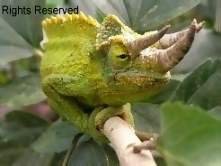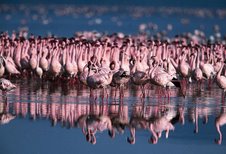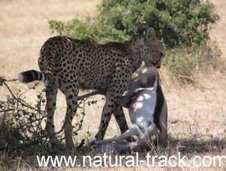Rwanda is a land of great diversity and beauty. The characteristic spectacular volcanoes and dense tropical forests dominate the north of the country, while gentle hills and valleys, calm lakes and turbulent rivers in both savannah and dense tropical vegetation dominate the rest of the country. In addition to nature, Rwanda offers a welcoming and culturally rich atmosphere.
Prior to the infamous genocide, Rwanda attracted adventurers through its natural treasures ranging from gorillas, rain forests to big game. Despite the hard times, today the country is once again on the road to a bright future. Leading the way are those same attractions that continue to thrill the adventurer, eco-tourist and or just plain nature-lover.
Popularly known as 'the land of a thousand hills', Rwanda has five volcanoes, twenty-three lakes and numerous rivers, some forming the source of the great River Nile. The landscapes in this 'green country' are truly breathtaking.
Hoisted as Africa’s most eco-destination and the alternative safari destination, Rwanda now boasts the mountain gorilla, authentic African culture, comfortable weather and excellent year-round wildlife viewing, unparalleled scenery and great food. Among all, there is safety and reliability in Rwanda whilst most of its attractions lay undiscovered. Numbering in their hundreds, the gorillas live in a protected area, with many rangers to make sure they are free from poachers.
The Virunga National Park in northern Rwanda is home to the world’s largest number of endangered mountain gorillas.
The gorillas can be viewed in their natural mountain habitats at a fairly close range. The park is also home to a great variety of bird life. The National Office for Tourism and National Parks (ORTPN) organizes guided tours.
When visiting the Land of a thousand hills, you should not miss out on the magnificent opportunity to visit Rwanda's National Volcano Park (NVP). The park consists of 125 square kilometer of mountain forest and is home to the six Virunga Volcanoes bordering DRC and Uganda.
Best known for its mountain gorilla inhabitants, what is now the NVP was originally part of the Albert National Park, the first national park created in Africa, established in 1925. Today, the park is managed and protected by the Rwandan Office of Tourism and National Parks.
The Akagera National Park in eastern Rwanda is teeming with wildlife both large and small. They range from Lions, Giraffe, Elephant and Hippopotamus to Hyena, Impala and Gazelle without mentioning the rich variety of bird life.
Although hiking and climbing the Volcanoes is currently not permitted, a gorilla visit can entail anything from a half an hour to a four hour trek through the forest, led by experienced trackers who have spent their entire lives living in or close to the forest. Your trek through the forest will not be easy, but will be enchanting as you weave through overhanging vines, moss covered Hagenia trees and giant Lobelias that thrive in the tropical climate of the forest. You may spot golden monkeys swinging from the bamboo, or see wild buffalo, bush duiker and a wide assortment of bird life.
Access to the NVP begins in the lively town of Ruhengeri, situated at the base of the entrance of the park. Ruhengeri has long been the base point for gorilla visits and entertains a stunning backdrop of Karisimbi, Visoke, Mikeno, Sabyinyo, Gahinga and Muhabura volcanoes.
Ruhengeri is easily reached from Rwanda's capital city, Kigali, either by private vehicle or by public taxi minibus. If you intend to make a gorilla visit, you will need to organise your own transport from Ruhengeri town to the park boundaries, where you will continue your trip on foot. Vehicles can be hired for this purpose in Ruhengeri town. Ruhengeri is also only a 45-minute drive away from Gisenyi and the stunning Lake Kivu.
Rwanda also has water bodies which are ideal for water sports and fishing. Lake Kivu in the west of the country and Lake Muhazi in the east are both ideal for water sports and fishing. Lake Kivu also offers beautiful beaches, jutting peninsulas and an archipelago of beautiful islands.
The Kinigi Guest House on the foot of Mount Sabyinyo was recently fully refurbished, and is now open. It offers very comfortable accommodation in cottages for two, four or eight people. It also offers a good restaurant and bar. Hotel Muhabura in Ruhengeri town also offers comfortable accommodation in reasonably priced single and double rooms equipped with mosquito nets and a good supply of running hot and cold water. The hotel also features a reasonable restaurant and bar and is complete with fax and telephone facilities.
PKP- Safaris in Kenya desk
Natural Track Safaris








